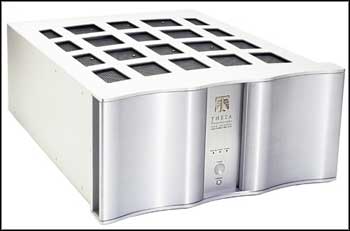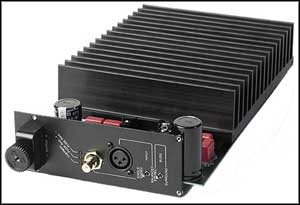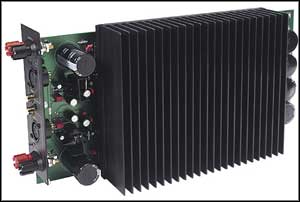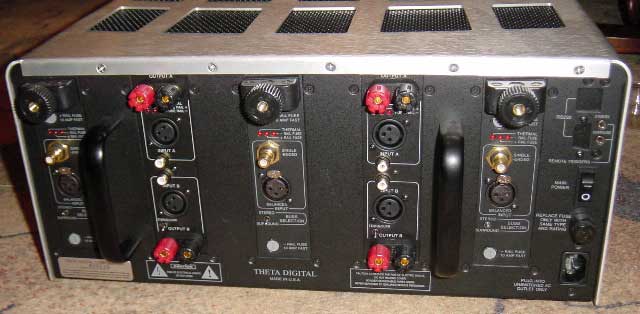|
|

|
|
Specifications:
●
Output: 225 Watts into 8 Ohms per mono
module, or 2x100 Watts into 8 Ohms per stereo module; Configurable with up
to 10 channels
●
Zero Global Negative Feedback
●
Fully Differential Balanced Design
●
Input Impedance: 50 kOhms
●
MFR: 0.3 Hz - 250 kHz ± 3 dB
●
THD: < 1%
●
Size: 8 7/16" H x 17 5/8" W x 23 1/2" D
●
Weight: 98 Pounds
●
MSRP: $6,000 Typical Configuration
Theta Digital
www.thetadigital.com | |
Introduction
Secrets reviewed the original Dreadnaught Multi-channel Power
Amplifier in December of 2001, and so for some readers, this review may
serve as an update. For me, it was a revelation.
I didn't really want to
review this amplifier – I was happy with my current system, and I did not
think that there would be that much difference. Frankly, an amplifier
that cost $6,000 or more seemed, well, excessive.
However, it didn't take
much listening time at all to discover that the Dreadnaught II sounded
considerably better than my then reference amplifier setup – a combination
of an Acurus 200x3 for the front channels, and two Hafler stereo
amplifiers for the four speakers in the rear.
So,
I found that amplifiers do sound different from one another, an idea that
is controversial with many consumers.
To make a long story short, I
bought the Dreadnaught II in a seven-channel configuration while reviewing
it, and it is now
serving as my reference amplifier for reviewing other components, as well
as for daily music and Home Theater (HT) usage.
To understand why, read
on.
A Modular Design
One of the nice things about the Dreadnaught II is the ability to
configure it for your exact needs today, while having the ability to
 upgrade as your needs change. Basically the Dreadnaught has
five slots that
can be used with any combination of 225 watt “mono” modules (top photo at right), or 2x100 watt
“stereo” modules (bottom photo at right). Both types of modules feature XLR balanced and RCA
single ended inputs. The amplifier modules are fully balanced. upgrade as your needs change. Basically the Dreadnaught has
five slots that
can be used with any combination of 225 watt “mono” modules (top photo at right), or 2x100 watt
“stereo” modules (bottom photo at right). Both types of modules feature XLR balanced and RCA
single ended inputs. The amplifier modules are fully balanced.
While one can imagine the Dreadnaught in
configurations as simple as a stereo amplifier, or as complex as a ten-channel amplifier for multi-room usage, it is the
five and seven-channel
configurations that are of the most interest for HT.
I first experienced the Dreadnaught configured with five 225
watt channels. At that point, I used two channels of my Acurus 200x3 for
the rear surround channels of my 7.1 setup. I used it this way for several
months, and it sounded great. It seemed clear to me, however, that my
ultimate setup would be the seven-channel configuration with three 225 watt modules for
the front speakers, and two stereo 100 watt modules for my four surround speakers. Acurus 200x3 for
the rear surround channels of my 7.1 setup. I used it this way for several
months, and it sounded great. It seemed clear to me, however, that my
ultimate setup would be the seven-channel configuration with three 225 watt modules for
the front speakers, and two stereo 100 watt modules for my four surround speakers.
In most setups, including mine, the surround speakers are considerably
closer to the listening area that the front speakers, and therefore need
less power to stay balanced in level. Surround effects are not usually
very intense anyway, and so do not
require 900 watts (4x225) to make their presence felt. Therefore, 4x100 is
plenty. So, I had the amplifier configuration changed to the
seven-channel package partway through the review period. (The term
“review period” is a bit ambiguous here as it soon became apparent that I
would not be able to let this amplifier go, it was just a question of when
I would pay for it and when I would write the review.)

Ergonomics
The Dreadnaught is a very nice looking amplifier in burnished aluminum
with beautifully curved surfaces. It is of impressive size and weight,
especially if it is sitting on the floor and needs to be put into an
equipment cabinet or rack. While it has handles on the back and nice
lifting areas on the front corners, at 111 pounds, or so, moving the
Dreadnaught II is a two-person job. I ended up moving it by myself – not
recommended.
Inputs and Outputs
The XLR connectors lock, and this feels very reassuring. The
speaker connectors for the mono 225 module are very solid and very easy to
use, but it is obvious that they are designed only for use with spade
connectors.
Getting two sets of inputs and speakers wires connected to the stereo module
is a bit of a challenge. I should mention that on “my” amplifier, the
top speaker terminals on the stereo module are positioned so that if the
speaker wires and spade connectors come in from the top, as one might
naturally do, there is possibility of shorting the spade connectors, and
hence the amplifier's outputs to the chassis – not good. So make sure that
either your spade connectors are well insulated, or do as I did, come in
from the bottom with the connectors.
Controls
Controls for audio power amplifiers are typically fairly simple. With the
Dreadnaught II there are controls to change the amplifier from “Operate”
to “Standby”, and from “Stereo” to “Surround”. This later feature is a
consequence of the user's ability, via a switch on the back of each
module, to assign the various modules to either the “Stereo” or “Surround”
buss. Thus if you are using a five-channel Dreadnaught for two-channel listing,
the unused modules are essentially put into standby mode, thus lessening
the load on the power supply.
Three mechanisms for provided for switching modes: front panel buttons,
1/8-inch mini jacks for each function, and an optional RS-232 control.
Unfortunately, mode control via the 1/8 mini jacks only respond to a 5-12
volt pulse, not the typical level supplied by most preamps for amplifier
control. This was a source of some frustration for me as you will read in
the comments section. I have since upgraded to the RS-232 control for
these functions and found a marvelous device from Celadon to convert IR
commands into RS-232 codes in the process. That combination works well and
provides reliable control of the various amplifier controls.
Design Considerations
It is hard to decide whether to call the Dreadnaught II a high-end audio
amplifier that can be configured for multi-channel usage, or a
multi-channel amplifier that has been designed using techniques typically
reserved for high-end mono or stereo amplifiers. Both are good
descriptions for the Dreadnaught II.
So what is the big deal? Why is designing a good amplifier a challenge,
and why would anyone spend this kind of money on an audio amplifier? After
all, it's not even “digital”, despite coming from a company with “Digital”
in its name, and that is known for its high quality digital products –
Theta Digital!
It turns out despite all the advances in “digital” audio, it still takes
analog components to provide the voltage and current gain (amplification)
necessary to drive our necessarily analog loudspeakers. Analog designs
need to deal with two issues, noise and distortion, as well as the
vagaries of driving “real” loudspeaker loads with a wide range of
frequencies, at low and very high sound levels, and while trying to
reproduce complex, dynamic musical passages.
So, despite the fact that virtually all amplifiers measure flat as a ruler
across a wide frequency bandwidth, and have distortion specification far
better than the loudspeakers they drive, amplifier reviews end up sounding
like wine tasting notes with subjective comments about warmth and openness
or transparency. The simple fact is that all not all Zinfandels taste the
same, and amplifiers don't really sound the same when driving real
loudspeakers loads with real music. Let's examine some of the reasons that
the Theta sounds so good.
Amplifier Design and Distortion
One major issue with amplifier design involves audible distortion that
arises in the amplification process. One common type of distortion is
Harmonic Distortion, a type of distortion that produces frequencies that
are integer multiples (e.g. 3x) of the original frequency.
Harmonic distortion occurs when the signal experiences any non-linear
element in the amplification process, typically at either very high or
very low signal levels. Amplifiers are often specified in terms of the
Total Harmonic Distortion (THD), typically measured using sine waves.
However, THD is not the whole story when it comes to audible distortion.
Other types of distortion include transient distortions that can occur at
all signal levels with rapidly changing or dynamic signals such as
experienced with music. The design of the Dreadnaught II places more weight
on minimizing these transient distortions than on a low THD specification.
While this is perhaps a matter of some controversy in the audio industry,
the excellent sound quality of the Dreadnaught speaks for itself – it
sounds very clean with music and movie soundtracks.
In traditional amplifier circuits, a device such as a transistor works
with a constant supply voltage, often called the “rail” voltage, and the
current through the transistor is ideally proportional to the voltage on
the transistor's input. In practice, power amplifier circuits typically
involve multiple stages that have been configured to provide the necessary
voltage and current gain with the “load” on the final stage being the
loudspeakers.
Harmonic distortion can happen if the output voltage necessary to
accurately reproduce the loudest passages approaches or exceeds the rail
voltage. In such cases, the amplifier is said to “clip” the output
waveform, and the loudest notes in that passage will go “splat” or seem
fuzzed. The naďve listener may say, “Wow, that sure is loud, what a great
sound system” as that is the way “loud” is supposed to sound, right?
Wrong! With an amplifier capable of reproducing the passage properly, the
loudest notes don't sound “loud” at all – no different from the others
notes - nothing exceptional.
Good power handling starts in the power supply – large and heavy are the
key words in this respect. It is worth remembering that the Dreadnaught
weights more than 100 pounds! Another clue to the Theta's excellent power
handling is that all of the Dreadnaught's modules are rated for twice the
power into a 4 Ohm load as they can put into an 8 Ohm load.
I have also been impressed that at the Home Theater shows I have attended,
e.g. CEDIA, that the Dreadnaught seems to be the most common amplifier
used in the various HT demo rooms by a variety of exhibitors showing their
own products. This is not an “official” count, but one does notice when
the amplifier being used to demo high end HT equipment is the same one you
have at home. It feels good, very good. And let's just say the demos
typically involve very high sound pressure levels in venues that are too
big to be called “rooms”. A Dreadnaught can put out an impressive amount
of sound. Power handling is not likely to be an issue with the Dreadnaught
II in any venue I can image.
Distortion at Low Signal Levels – Class A Design
Ironically, low signal levels can also be problematic for amplifiers,
especially “solid-state” amplifiers. This is because transistors, by their
nature, don't pass or amplify signals below a few tenths of a volt on
their input. Since sine waves, and musical signals in general, are always
passing through zero, the non-linear behavior at the zero crossing can be
a significant cause of harmonic distortion. As a consequence, amplifier
circuits must be “biased” with a bias voltage so that small signal levels
can be amplified without significant distortion.
Traditional amplifier designs are often characterized by the nature of the
strategy used for this bias voltage. Class A designs use a bias voltage
above this cutoff so that the transistor is always conducting or always
“on”. Class A designs have the lowest possible zero crossing distortion,
but are inefficient, as they are always drawing energy from the power
supply, even with no input signal. Class A audio amplifiers therefore run
warm even when played at very low volume levels.
The alternative is to lower the bias voltage to the point that the
transistor is not conducting in the absence of an input signal, the so
called Class B or the Class AB designs typically used in audio amplifiers.
The problem here is that there will necessarily be some zero crossing
distortion with these designs, and therefore harmonic distortion at low
signal levels.
The Dreadnaught II is biased heavily towards Class A, no compromise here.
In the 5x225 configuration, the Dreadnaught II draws 275 watts of power at
idle, i.e., with no input signal. It runs warm – it is designed to do so.
With traditional amplifier designs, there is necessarily a tradeoff
between sound quality and efficiency. It should be noted however that
there are several newer amplifier designs, such as Class H, that vary the
rail voltage in response to, or hopefully, anticipation of, the demand,
thus significantly improving efficiency – Class H designs draw very little
power with no input signal. There are also “digital” amplifier designs
today (Class D) that use pulse modulation to construct the output waveform, that
also achieve remarkable efficiency. The object of these designs is
efficiency however, and not necessarily sound quality.
The Dreadnaught is a traditional amplifier design that clearly goes for
sound quality at the expense of efficiency and makes no apologies for it.
As a consequence, you will need to provide adequate ventilation for the
Dreadnaught II, with 1/2 inch of clearance on the sides and 3 inches on
top. I have my Dreadnaught installed in a cabinet (closed door in front,
open in back) with no problem, and while it is likely not necessary, I
have a whisper fan blowing air through the 5 inch airspace above the
amplifier.
I was surprised however, to find that even when in the “Standby” mode, the
amplifier (5x225) still used 150 watts of power and remained quite warm.
Again this is by design, as the Dreadnaught II is meant to provide
excellent performance as soon as it is taken out of standby. If you choose
to leave the amplifier on, and in standby when not in use, this will have
a small, but noticeable effect on your electric bill. To save energy, not
to mention the earth, I turn the amplifier on and off as needed. Theta
says that turning the amplifier on and off is not a problem for the
Dreadnaught, but that it might take a half an hour or so for the amplifier
to warm up to the point that it achieves its ultimate performance.
If you want to try switching the Dreadnaught on and off, don't expect the
relays in your average power conditioner/AC switching unit to handle the
surge of current when the amplifier switches on – it won't, trust me. I now
use a 30-amp contactor to give a fairly “hard” connection to the wall
outlet.
Click HERE to
go to Part II
Terms and Conditions of Use

|


 upgrade as your needs change. Basically the Dreadnaught has
five slots that
can be used with any combination of 225 watt “mono” modules (top photo at right), or 2x100 watt
“stereo” modules (bottom photo at right). Both types of modules feature XLR balanced and RCA
single ended inputs. The amplifier modules are fully balanced.
upgrade as your needs change. Basically the Dreadnaught has
five slots that
can be used with any combination of 225 watt “mono” modules (top photo at right), or 2x100 watt
“stereo” modules (bottom photo at right). Both types of modules feature XLR balanced and RCA
single ended inputs. The amplifier modules are fully balanced. Acurus 200x3 for
the rear surround channels of my 7.1 setup. I used it this way for several
months, and it sounded great. It seemed clear to me, however, that my
ultimate setup would be the seven-channel configuration with three 225 watt modules for
the front speakers, and two stereo 100 watt modules for my four surround speakers.
Acurus 200x3 for
the rear surround channels of my 7.1 setup. I used it this way for several
months, and it sounded great. It seemed clear to me, however, that my
ultimate setup would be the seven-channel configuration with three 225 watt modules for
the front speakers, and two stereo 100 watt modules for my four surround speakers.



